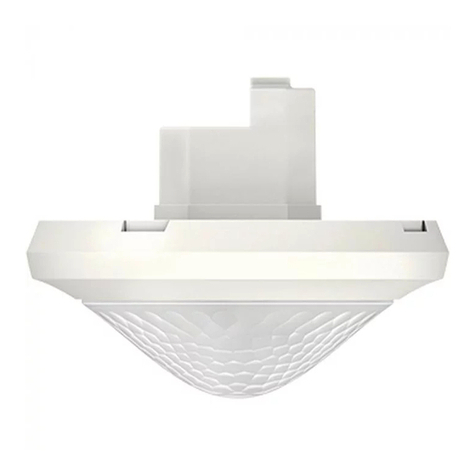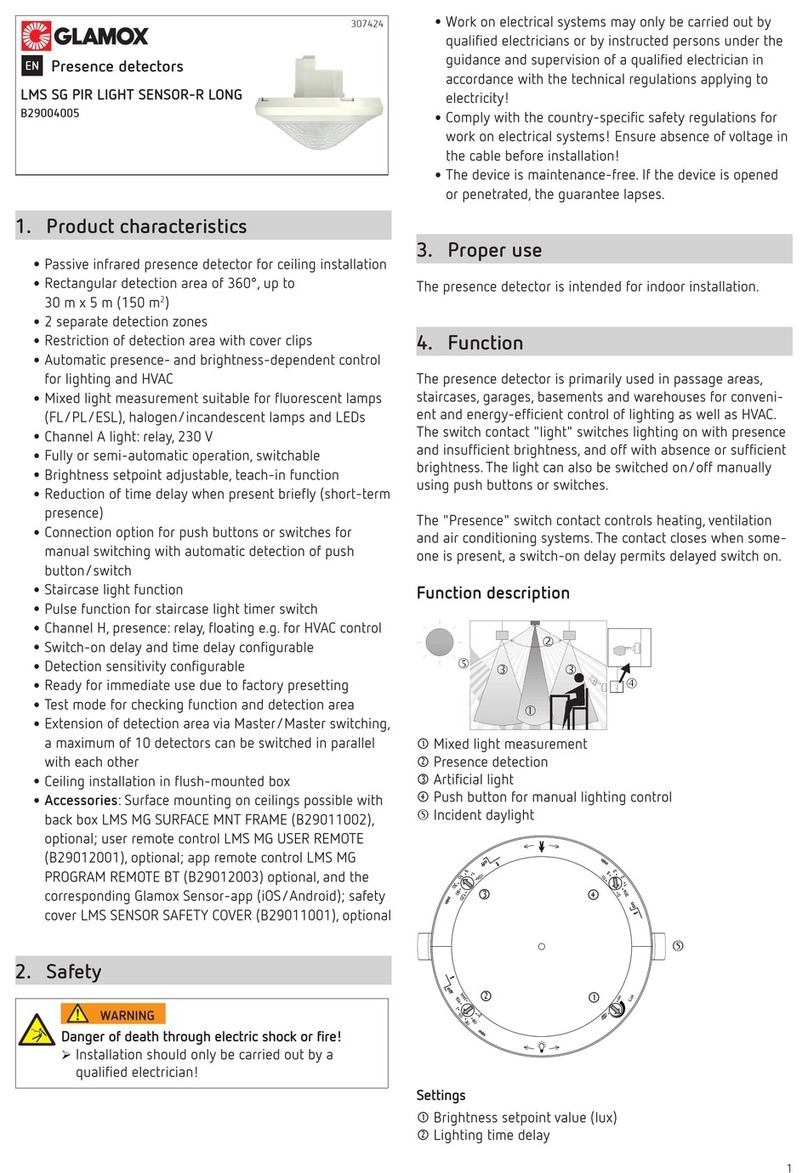
4
•All connected buttons are active. Switching on and off as
well as dimming are possible.
•Time delay: 10 min.
Configuring the lighting groups with
•LMS MG PROGRAM REMOTE BT/Glamox Sensor-app
•Buttons or LMS MG USER REMOTE
Configuring the lighting groups with the LMS MG PROGRAM
REMOTE BT/App
Connect the LMS MG PROGRAM REMOTE BT with the corre-
sponding Glamox Sensor-app.
Place the LMS MG PROGRAM REMOTE BT under the detec-
tor (direct the remote control towards the detector).
Select LMS MG PIR CLS SENSOR-R LONG as the type in the
app.
In the "DALI conguration" menu, select the required group
assignment.
For the DALI conguration, there are 3 options available:
y "Group assignment (unaddress.)": only DALI EBs without a
group address are processed.
y "Group assignment (all)": all connected DALI EBs are con-
gured. NOTE: All existing group assignments with group
number 1 or 2 are deleted.
y "Change group assignment": the next existing EB is
searched for and selected.
▻After selecting the required group assignment, the
detector is in the programming mode.
▻A DALI light starts to pulse (random order).
Use to assign the required C1 or C2 channel to the DALI
EB.
▻ As conrmation, the light dims to 20%.
▻The next DALI light starts to pulse. One after the other,
the lighting groups are assigned to all the lights.
•For group assignment (unaddress.) or (all): if all DALI EBs
are assigned to a lighting group, the detector terminates
the conguration process and restarts (startup phase of
30 s). The detector then switches to the normal opera-
ting mode and the conguration is completed.
LIf necessary, the conguration process can be ended by
pressing „End“ (left function button).
▻In this case, the system is not ready for operation.
•If „Change group assignment“ has been selected, use the
right „>“ button to switch to the next DALI EB without
changing the lighting group.
When all required changes have been made, end the con-
guration process by pressing „End“ (left function button).
Configuring the lighting groups using buttons
Set the <Conguration button/RC> parameter to "Enabled".
All connected buttons can be used for the conguration.
Press any button 5 times briey (< 0.4 s) and press and
hold once (> 15 s).
▻The LED is switched off.
▻A DALI light starts to pulse (random order).
▻The lighting group is assigned by pressing the approp-
riate button:
y 1 x short button press = channel C1
y 2 x short button press = channel C2
▻ As conrmation, the light dims to 20 % (3 s after the
last button press).
▻The next DALI light starts to pulse. One after the other,
the lighting groups are assigned to all the lights.
•If all DALI EBs are assigned to a lighting group, the
detector terminates the conguration process and
restarts (startup phase of 30 s).
▻The detector switches to the normal operating mode
and the conguration is completed.
LIf required, the conguration process can be ended by
pressing and holding any button for longer than 15 s.
The detector restarts.
▻In this case, the system is not ready for operation.
LInstead of using the button, the conguration can also
be carried out with the ON/OFF buttons on the LMS MG
PROGRAM REMOTE BT/LMS MG USER REMOTE.
Checking the configuration
The assignment of the lighting groups can be checked by
switching the individual lighting groups on or off using but-
tons, the LMS MG PROGRAM REMOTE BT/App (for the app,
select the "Control commands" menu).
LChanging the lighting group for DALI EBs: use the LMS MG
PROGRAM REMOTE BT/App to change the DALI congura-
tion via the "Change group assignment" command.
LWith the button: the whole DALI conguration must be
re-executed.
Switch-on response (congured system)
If voltage is applied, the presence detector goes through two
phases which are indicated by the LED:
1. Start-up phase (30 s)
•The red LED ashes in one-second intervals; the lighting
is switched on with the switch on dimming value.
•The detector does not react to button commands or
to the LMS MG PROGRAM REMOTE BT/LMS MG USER
REMOTE.
•If absent, the lighting is switched off after 30 s.
2. Operation
•The red LED is off. The constant light control or switching
mode are started.
▻The detector is ready for operation.
7. Functions
Z1 Z2
Mixed light measurement
Presence detection
Articial light
Button for manual lighting control
Incident daylight





























